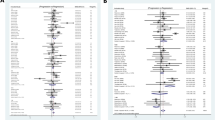Abstract
This study contrasts the sensitivity of four quantitative coronary angiography (QCA) measures (percent diameter stenosis [%S], minimum lumen diameter, average segment diameter, and percent involvement) in detecting 2-year treatment effects of two lipid-lowering therapies and reports on the longitudinal pattern after 4 years of treatment on the primary QCA trial endpoint (%S) for all, mild/moderate (<50%S), and severe lesions (≥50%S). Patient cohorts were followed up from two randomized, placebo-controlled clinical trials of lipid-lowering therapies—colestipol/niacin in the Cholesterol Lowering Atherosclerosis Study (CLAS) and lovastatin in the Monitored Atherosclerosis Regression Study (MARS). Identical QCA methodology was used. In CLAS, the largest 2-year treatment effect size (=0.60) was noted for %S. In MARS, equivalent 2-year effect sizes (=0.15) were noted for three QCA measures. The largest 2-year effect size in %S was found in CLAS for mild/moderate lesions (=0.55) and in MARS for severe lesions (=0.31). Treatment in CLAS led to regression of disease in the first 2 years; treatment in MARS slowed progression of disease in the first 2 years and led to regression of disease after 4 years. Colestipol/niacin reduced progression of mild/moderate and severe lesions over the first 2 years of therapy; lovastatin reduced the progression of severe lesions over the last 2 years of therapy. We conclude that reducing the progression of atherosclerosis is not a simple proposition; maximal therapy for reducing and stabilizing atherosclerosis most likely will result from the selection of agents targeted at specific lesions.
Similar content being viewed by others
References
Selzer RH, Hagerty C, Azen SP, et al. Precision and reproducibility of quantitative coronary angiography with applications to controlled clinical trials: a sampling study. J Clin Invest 1989;83:520-526.
Brown BG, Lin JT, Kelsey S, Passamani ER, Levy RI, Dodge HT. Progression of coronary atherosclerosis in patients with probable cholesterolemia. Atherosclerosis 1989;9:I81-I90.
Blankenhorn DH, Johnson RL, Nessim SA, Azen SP, Sanmarco ME, Selzer RH. The Cholesterol Lowering Atherosclerosis Study (CLAS): design, methods, and baseline results. Cont Clin Trials 1987;8:356-387.
Mack WJ, Azen SP, Dunn M, Hodis HN. A comparison of quantitative computerized and human panel coronary end point measures: implications for the design of angiographic trials. Cont Clin Trials 1997;18:168-179.
Blankenhorn DH, Nessim SA, Johnson RL, Sanmarco ME, Azen SP, Cashin-Hemphill L. Beneficial effects of combined colestipol-niacin therapy on coronary atherosclerosis and coronary venous bypass grafts. JAMA 1987;257:233-240.
Cashin-Hemphill L, Mack WJ, Pogoda JM, Sanmarco ME, Azen SP, Blankenhorn DH. Beneficial effects of colestipol-niacin on coronary atherosclerosis. A four year follow-up. JAMA 1990;264:3013-3017.
Blankenhorn DH, Selzer RH, Mack WJ, et al. Evaluation of colestipol/niacin therapy with computer-derived coronary end point measures: a comparison of different measures of treatment effect. Circulation 1992;86:1701-1709.
Blankenhorn D, Azen SP, Crawford D, et al. Effects of colestipol-niacin therapy on human femoral atherosclerosis. Circulation 1991;83:438-447.
Mack WJ, Selzer RH, Hodis HN, et al. One-year reduction and longitudinal analysis of carotid intima-media thickness associated with colestipol-niacin therapy. Stroke 1993;24:1779-1783.
Cashin-Hemphill L, Kramsch DM, Azen SP, et al. The Monitored Atherosclerosis Regression Study (MARS): design, methods, and baseline results. On-line J Curr Clin Trials 1992; Document 26.
Blankenhorn DH, Azen SP, Kramsch DM, et al. Coronary angiographic changes with lovastatin therapy: the Monitored Atherosclerosis Regression Study (MARS). Ann Intern Med 1993;119:969-976.
Hodis HN, Mack WJ, LaBree L, et al. Reduction in carotid arterial wall thickness using lovastatin and dietary therapy: a randomized, controlled clinical trial. Ann Intern Med 1996; 124:548-556.
Cohen J. Statistical Power Analysis for the Behavioral Sciences, rev. ed. Hillsdale, NJ: Erlbaum, 1987.
Brown G, Albers JJ, Fisher LD, et al. Regression of coronary artery disease as a result of intensive lipid-lowering therapy in men with high levels of apolipoprotein B. N Engl J Med 1990;323:1289-1298.
Watts GF, Lewis B, Brunt JNH, et al. Effects on coronary artery disease of lipid-lowering diet, or diet plus cholestyramine, in the St. Thomas' Atherosclerosis Regression Study (STARS). Lancet 1992;339:563-569.
Uemura K, Sternby N, Vanecek R. Grading atherosclerosis in aorta and coronary arteries obtained at autopsy. Application of a tested method. Bull WHO 1964;31:297-320.
McGill HC. Introduction to the geographic pathology of atherosclerosis. Lab Invest 1968;18:4565-4567.
Deupree RH, Fields RI, McMahan CA, Strong JP. Atherosclerotic lesions and coronary heart disease. Key relationships in necropsied cases. Lab Invest 1973;28:252-262.
Brooks SH, Crawford DW, Selzer RH, Blankenhorn DH, Barndt RJ. Discrimination of human arterial pathology by computer processing of angiograms for serial assessment of atherosclerosis change. Comput Biomed Res 1978;11:469-480.
Mack WJ, Hodis HN. Efficacy of interventions designed to inhibit the progression of coronary atherosclerosis. Dial Res Clin Pract 1996;30:S37-S53.
Brown BG, Zhao X-Q, Sacco DE, Albers JJ. Lipid lowering and plaque regression: new insights into prevention of plaque disruption and clinical events in coronary disease. Circulation 1993;87:1781-1791.
Ornish D, Brown SE, Scherwitz LW, et al. Can lifestyle changes reverse coronary heart disease? Lancet 1990; 336:129-133.
Fuster V, Badimon L, Badimon JJ, Chesebro JH. The pathogenesis of coronary artery disease and the acute coronary syndromes. N Engl J Med 1992;326:242-309.
Singh RN. Progression of coronary atherosclerosis. Clues to pathogenesis from serial coronary arteriography. Br Heart J 1984;52:451-461.
Glagov S, Weisenberg E, Zarins CK, et al. Compensatory enlargement of human atherosclerotic coronary arteries. N Engl J Med 1987;316:1371-1375.
Brown BG, Hillger L, Zhao X-Q, Poulin D, Albers JJ. Types of change in coronary stenosis severity and their relative importance in overall progression and regression of coronary disease: observations from the FATS Trial. Ann NY Acad Sci 1995;748:407-417.
Author information
Authors and Affiliations
Rights and permissions
About this article
Cite this article
Mack, W., Xiang, M., Shircore, A. et al. Efficacy of Two Lipid-Lowering Treatments on Quantitative Coronary Angiographic Endpoints. Cardiovasc Drugs Ther 14, 411–418 (2000). https://doi.org/10.1023/A:1007816300468
Issue Date:
DOI: https://doi.org/10.1023/A:1007816300468




